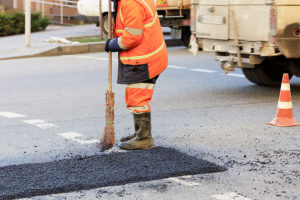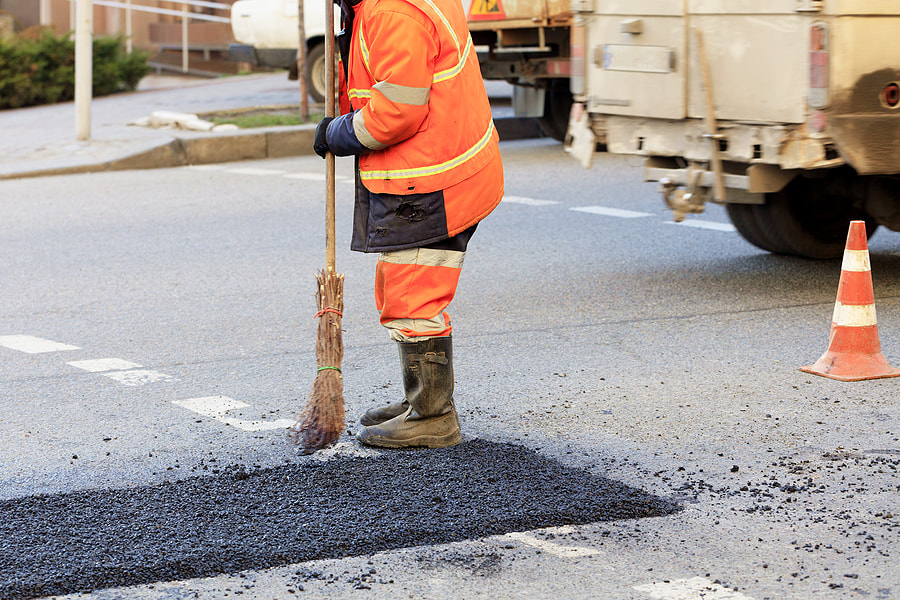When you think of patching, the first thing likely to come to mind is clothes. Patching in clothes is this wonderful technique that makes our clothes that have holes, wearable again. This same technique can be used on damaged and distressed roads, driveways, and parking lots to restore function to the surface. Due to traffic and different seasons at one point or another, your road is going to experience some damage. Patching is the process of filling in these distressed areas such as cracks, potholes, sinkholes, or broken-up areas with new material to make the surface functional. There are various techniques used to create patches on roads. In this article, we discuss some of the most commonly used for repair.
Throw and Go Patching
This method is the easiest, quickest, low-costing, and least efficient patch to apply. It is usually used exclusively as a temporary fix when an immediate repair is required, or the weather is too cold to do better Patch. The patch is applied by throwing in your patch mix into an unprepared (no debris or water removed) hole or crack and then left without any compaction of the material. Compaction is left to traffic.
Throw and Roll Patching
This patching technique is just a slight step-up from the throw-and-go technique. The only difference is that compaction is conducted by driving your car, truck, or trailer over the patch. While this fix is also temporary, it does create a more efficient patch, due to the compaction is done, which creates a tighter patch. Furthermore, if top-quality material is used in the patch, the patch becomes more effective and can last longer.
Spray Patching
This type of Patching offers a longer-lasting solution compared to the above methods. As the name suggests, this technique utilizes specialized equipment to spray the patch mix into the crack or pothole. In this method, the distressed area has to be properly cleaned of any debris and water before any patching material is added to ensure a proper patch. You should note that no compaction is needed when using this method since the new material is sprayed on, creating a tight patch without the need for compaction.
Semi-Permanent Patching
This patching technique is one of the best methods to repair distressed areas. It provides exceptional longevity, but it does require a lot of surface prep. This type of patch involves sawing out some of the damaged pavement and a small area surrounding it until you get to sound base. The new hole is usually cut into a square or a rectangle, then cleaned of any debris and water, filled in with patch material, and then compacted with a vibratory roller or plate. This process creates a tight patch that will last.
Full-Depth Patching
This patch technique is used to create permanent patches making it the most effective and longest-lasting method. Nonetheless, it is also the most complex. This method involves cutting out the damaged road to its foundation. The foundation is then inspected, repaired, and strengthened if necessary. The full-depth patch is the only technique that repairs the structural integrity of the damaged area, which is what makes it more effective.
Infrared Patching
 This is a newer method of the patch. It is also considered the cleanest and greenest patch method as it does not involve any cutting or removal of any damaged surface. Rather this patch method uses an infrared heating panel to heat the old asphalt pavement, softening it to a workable state. New asphalt is then, poured in, and the old and new asphalt seamlessly bond together forming a waterproof seamlessly-blended patch. The patch is then leveled to the proper level and compacted.
This is a newer method of the patch. It is also considered the cleanest and greenest patch method as it does not involve any cutting or removal of any damaged surface. Rather this patch method uses an infrared heating panel to heat the old asphalt pavement, softening it to a workable state. New asphalt is then, poured in, and the old and new asphalt seamlessly bond together forming a waterproof seamlessly-blended patch. The patch is then leveled to the proper level and compacted.
There you have it, the commonly used techniques for patch repair. Furthermore, if you need more information on patching or are looking for patch contractors to fix your pavement, Commonwealth is here for you.
Address
Commonwealth Paving, 136 Outerloop, Louisville, Kentucky 40214
Phone: 502-459-7283, Fax: 502-456-2678
Opening Hours
| Monday | 9:00 AM – 5:00 PM |
| Tuesday | 9:00 AM – 5:00 PM |
| Wednesday | 9:00 AM – 5:00 PM |
| Thursday | 9:00 AM – 5:00 PM |
| Friday | 9:00 AM – 5:00 PM |
| Saturday | Closed |
| Sunday | Closed |







